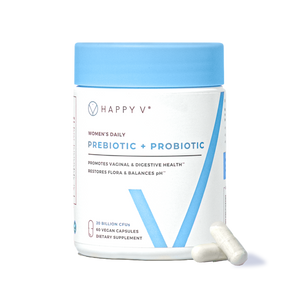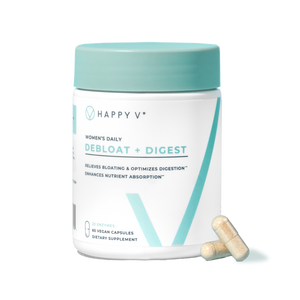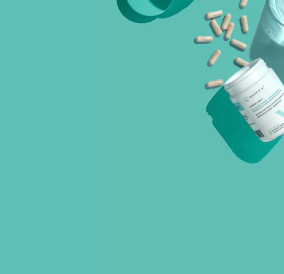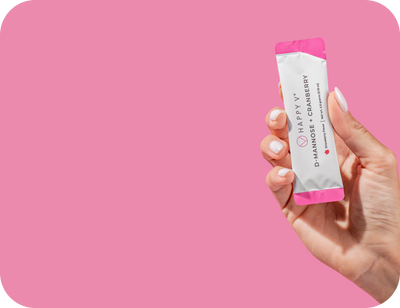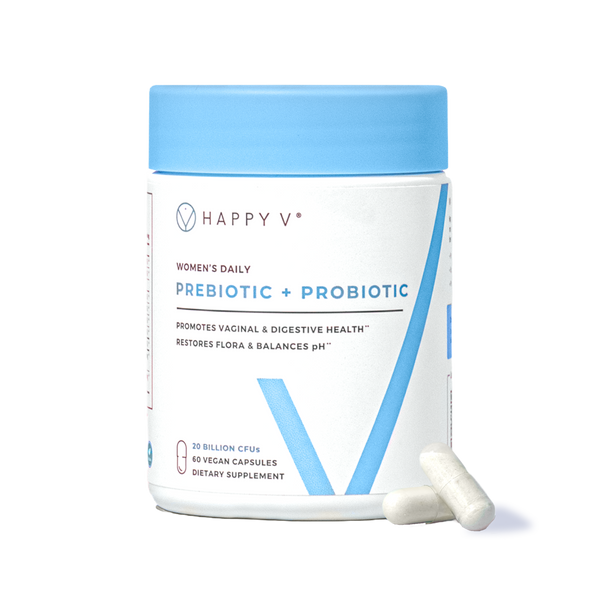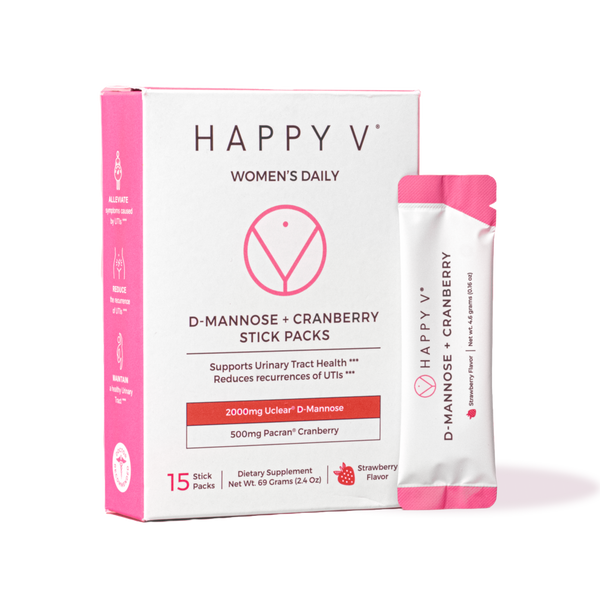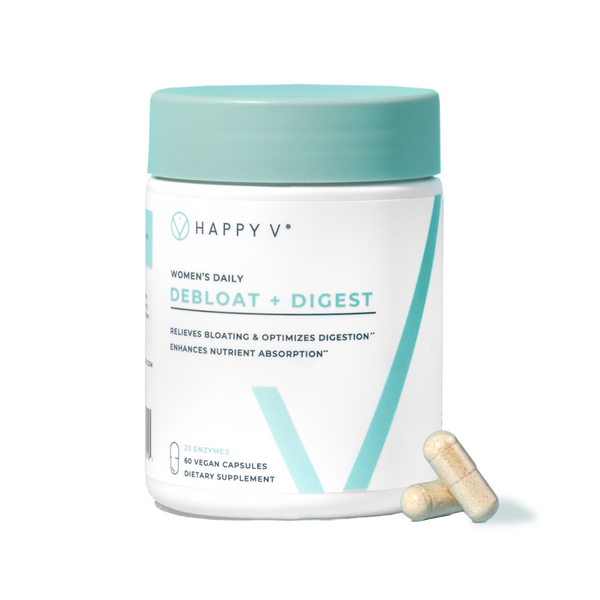- Fact Checked
- October 15, 2025
- 19 min read
Meet Your Vagina's Best Friend: Lactobacillus Crispatus
Table of Contents
Table of Contents
This tiny but powerful probiotic works around the clock to keep things balanced, block unwanted intruders, and protect your overall vaginal health1. It’s been quietly doing this job for decades, and now research is finally giving it the spotlight it deserves. Here’s why L. crispatus is becoming such a star in women’s health, and why it matters for you.
This post is for informational purposes only and does not constitute medical advice. See full disclaimer below.
What Is Lactobacillus Crispatus?
Lactobacillus crispatus is a member of the Lactobacillus species family, a huge group of beneficial microorganisms that you might recognize from probiotic supplement labels and yogurt2. The Lactobacillus species get their name from what they do best: produce lactic acid (lacto = milk, bacillus = rod-shaped bacteria)3. These microbes are the MVPs of fermentation, turning sugars into acids that actually give foods like yogurt, sauerkraut, and kimchi those tangy flavors.
The Lactobacillus Family: Your Body's Friendly Neighbors
Lactobacillus species live throughout your body—in your gut, mouth, and for women, especially in the vaginal microbiome. They're like the neighborhood watch of your vaginal microbiota, keeping things safe and balanced. Different Lactobacillus species have different specialties:
- Lactobacillus acidophilus - The gut health champion you see in most probiotic supplements
- L. gasseri - Known for supporting immune function and digestive health
- L. plantarum - The versatile one that helps with both gut and overall inflammation
- L. reuteri - Specializes in oral health and immune support
- Lactobacillus crispatus - The vaginal health superstar we're talking about today
What Makes L. Crispatus the Vaginal Health All-Star?
While all Lactobacillus species share the family trait of producing lactic acid, L. crispatus is specifically adapted to thrive in the vaginal environment4. While other Lactobacillus species might visit or temporarily colonize the genital tract, L. crispatus has evolved to make this environment its permanent home5, creating the most effective protective barrier possible.
Basically, the crispatus strain operates like a three-layer security system:
Layer 1: The Acid Test - It produces lactic acid, keeping your vaginal pH between 3.8-4.56. This acidic environment is like kryptonite to harmful bacteria and yeast. Bad bugs simply can't survive in this acidic wonderland.
Layer 2: The Bodyguard - Through advanced research using 16s rrna sequencing, scientists have shown how L. crispatus adheres to epithelial cells. Basically, by physically taking up space on vaginal tissue, L. crispatus literally crowds out the troublemakers before they can set up shop7.
Layer 3: The Chemical Warfare - Along with lactic acid, Lactobacillus crispatus also produces hydrogen peroxide and bacteriocins (natural antimicrobial substances) that actively fight off pathogens. It's like having a personal army with really good weapons.
What the Research Really Says
The scientific community has been pretty obsessed with Lactobacillus crispatus for good reason. The research (published in major journals accessible through PubMed and Google Scholar, if you’re ever interested) is consistently impressive. Here’s just some of what that research has to say about how L. crispatus benefits your health.
Bacterial Vaginosis Prevention
Multiple large-scale studies have shown that women with L. crispatus-dominated vaginal microbiota have up to 85% lower rates of bacterial vaginosis (BV).
A 2018 study following 5,000 reproductive-age women over two years found that those with higher Lactobacillus crispatus levels experienced BV recurrence at less than half the rate of women with other bacterial profiles. This anaerobic infection, often caused by gardnerella vaginalis overgrowth, represents a classic example of vaginal dysbiosis that this probiotic prevents8.
UTI Protection
Research published in major microbiology journals shows that healthy women with abundant Lactobacillus crispatus have 60-70% fewer urinary tract infections. The bacteria creates a protective barrier that prevents E. coli and other UTI-causing microorganisms from ascending from the vagina to the urinary tract9.
Yeast Infection Protection
Studies also suggest that L. crispatus helps defend against Candida albicans, the yeast behind most vaginal yeast infections10. By producing lactic acid and hydrogen peroxide, L. crispatus makes the vaginal environment less friendly for yeast to grow and spread. Women with strong L. crispatus populations tend to have lower recurrence rates of yeast infections, making this probiotic an important ally for anyone dealing with frequent flare-ups.
STI Transmission Reduction
Perhaps most remarkably, studies indicate that robust L. crispatus populations can reduce HIV transmission risk by up to 40%. It also shows protective effects against herpes, chlamydia, and gonorrhea transmission.
Of course, this doesn’t mean L. crispatus is a substitute for condoms or other safer-sex practices. It’s an extra layer of natural protection, not your only line of defense.
How Well-Studied Is This?
Lactobacillus crispatus isn’t a wellness fad. It’s one of the most researched probiotics for women’s health11, with more than 30 years of scientific studies behind it. Researchers don’t just look at it one way. They use multiple tools, from high-tech gene sequencing to hands-on lab tests and even animal models, to fully understand how this bacterium works.
How Researchers Study L. crispatus
- Gene sequencing (16S rRNA): Think of this as a microbiome census. By sequencing genetic material from vaginal swabs, scientists can identify which bacteria are present, how much of each, and how the balance shifts over time12.
- Adhesion assays: In the lab, researchers literally watch how L. crispatus sticks to vaginal cells—or even sperm. This helps explain its dual role as both protector (blocking pathogens) and “sperm selector.”
- Sperm motility analysis: Using computer-assisted microscopes, scientists track sperm swimming speed, movement patterns, and energy levels after exposure to L. crispatus. These tests show how the bacteria can slow weaker sperm.
- Calcium signaling assays: Since calcium powers sperm movement and immune responses, researchers measure how L. crispatus alters calcium levels inside different cells to understand its influence on fertility and inflammation.
- Culture-based studies: Scientists grow L. crispatus alongside harmful microbes in the lab to see what antimicrobial compounds it produces and how effective they are at blocking pathogens.
The Role of Animal Models
Animal studies—often using rats—are another key piece of the puzzle. In these experiments, researchers administer L. crispatus vaginally, then track fertility rates, pregnancy outcomes, and offspring health. These models have shown that while conception rates can dip slightly, embryo health, maternal health, and even the pups’ development remain unaffected. In fact, compared to antibiotic-exposed groups, offspring in the L. crispatus group grow normally and perform well on behavioral tests.
Why Multiple Methods Matter
No single experiment tells the whole story. By combining sequencing, lab assays, sperm analysis, and animal models, scientists can connect the dots: how L. crispatus attaches to cells, how it changes calcium signaling, how that impacts fertility, and how it influences pregnancy and offspring health. This layered evidence is why experts are so confident in its protective role.
Advanced Research on L. crispatus
If you’re ready to nerd out a little, here’s where things get fascinating. Research on Lactobacillus crispatus goes far beyond everyday vaginal balance. It touches fertility, pregnancy, and even how a mother’s microbiome can shape her baby’s future health.
Other Protective Elements
Along with producing lactic acid and hydrogen peroxide that prevent vaginal infections, L. crispatus impacts our health in other ways.
One of the most fascinating discoveries about Lactobacillus crispatus is how it interacts with calcium signaling inside our cells13. Calcium isn’t just about strong bones, it’s also a critical messenger that tells cells how to behave. By tweaking calcium levels, L. crispatus can influence how different systems in the body work.
-
In vaginal cells: Calcium plays a role in how strong and connected the epithelial cells (the lining of the vagina) are. By influencing calcium, L. crispatus helps tighten and reinforce this barrier, making it harder for pathogens to break through. Think of it like strengthening the walls of a fortress.
- In immune cells: Calcium signals help regulate how the immune system responds. By modulating these signals, L. crispatus can calm excessive inflammation.
- In sperm cells: Calcium is the “fuel” sperm rely on to power their movement. When L. crispatus binds to sperm, it lowers calcium inside the cell, which slows them down and makes it harder to swim through cervical mucus. For some couples, this acts as a natural quality-control filter; for others, especially those already facing fertility struggles, it can make conception more difficult (more on this below).
Pregnancy Benefits
Research in both humans and animal models highlights the protective role of L. crispatus–dominated vaginal microbiomes:
- 50% lower rates of preterm birth in women with strong L. crispatus populations.
- Reduced risk of chorioamnionitis and lower group B strep colonization, lowering the need for antibiotics during labor.
- Decreased postpartum infection risk, improving maternal recovery.
- Animal models confirm measurable benefits: In rat reproduction studies, pregnancy rates dropped from 75% in controls to ~62.5% in the L. crispatus group—indicating reduced conception odds, but importantly, no adverse effects on maternal health or embryo quality.
Baby Health Benefits
The impact of maternal L. crispatus carries over to offspring health:
- Normal fetal development: No increase in malformations compared to controls.
- Healthy litter sizes: The number of pups born in L. crispatus groups was comparable to controls, confirming no reproductive toxicity.
- Physical development: Offspring showed normal weight gain and growth trajectories.
- Neurobehavioral development: Babies from L. crispatus–exposed mothers performed normally on activity and exploration tests, unlike pups from antibiotic-treated mothers, who showed developmental setbacks.
The Microbiome Handoff
During vaginal birth, babies get a “starter pack” of microbes from their mothers, and L. crispatus is one of the most important gifts14. This early exposure seeds the infant gut and immune system, with benefits that can last well into childhood:
- Stronger gut barrier function in the first year15
- Healthier immune system development
- Lower risk of infections in infancy
- Reduced likelihood of allergies and asthma later in childhood
But here’s the catch: when antibiotics disrupt the maternal vaginal microbiome, that handoff looks very different. Instead of passing down protective Lactobacillus species, babies may inherit a less stable microbial community16. Research shows this can lead to weaker gut barrier function, greater susceptibility to infections, and even higher risks of allergy or asthma later in life.
In short, a mom’s vaginal microbiome—especially one rich in L. crispatus—doesn’t just protect her during pregnancy; it sets her baby up for a stronger, healthier start. When antibiotics wipe out that balance, the opposite can happen.
The Fertility Connection
Research shows that L. crispatus doesn’t just support vaginal health, it also interacts directly with sperm.
By attaching to sperm cells, it reduces their calcium levels, which slows movement and makes it harder for sperm to swim through cervical mucus. Scientists sometimes describe this as a kind of natural “sperm selector.”
-
Potential upside: This selective pressure may help filter out weaker sperm, increasing the chances of healthier pregnancies when conception does occur.
- Potential challenge: For couples already facing sperm-related fertility issues (like low count or poor motility), this extra hurdle could make conception more difficult.
What animal studies show: In reproductive studies using rat models, pregnancy rates were measurably lower in groups exposed to L. crispatus (about 62.5% compared to 75% in controls). Importantly, while conception was less likely, embryo health, maternal health, and offspring development were unaffected. This suggests that L. crispatus may reduce the odds of getting pregnant but does not harm pregnancies once established.
Why this matters: The research makes a clear distinction: L. crispatus may influence conception rates through its sperm-binding and motility-reducing effects, but it does not negatively impact pregnancy outcomes or fetal development. For some couples, this could mean extra protection against weaker sperm. For others, and particularly those already struggling with fertility, it could add an unexpected layer of difficulty.
Why This Matters for Women’s Health
Taken together, all this research shows that L. crispatus isn’t just another “good bacteria”; it’s a powerhouse regulator of vaginal and reproductive health. It protects against BV and yeast infections, supports healthier pregnancies, and may even shape a baby’s long-term health.
Because of these wide-ranging effects, scientists are now testing advanced applications like:
- Targeted L. crispatus probiotics
- Vaginal microbiome transplants for chronic imbalance
- New treatments for recurrent UTIs
Bottom line: L. crispatus plays a central role in reproductive and vaginal health. Whether it’s supporting pregnancy outcomes, protecting against infections, or acting as a natural “sperm filter,” this tiny bacterium has a big impact.
Who Should Consider L. Crispatus Support?
Given everything we now know about Lactobacillus crispatus, both its benefits and its nuanced effects, let's talk about who might benefit most from focusing on this particular probiotic strain.
Perfect Candidates for L. Crispatus Focus
Women with Recurrent Infections
If you're dealing with:
- Recurring urinary tract infections (especially 3+ per year17)
- Frequent bacterial vaginosis episodes
- Chronic yeast infections that keep coming back
- Post-antibiotic vaginal infections that seem to cycle
You're likely an ideal candidate. The research strongly supports lactobacillus crispatus for breaking these frustrating infection cycles.
Women Planning Pregnancy (With Considerations)
L. crispatus can be excellent for:
- Creating optimal conditions for a healthy pregnancy once conception occurs
- Reducing pregnancy complications and supporting fetal health
- Building a healthy vaginal microbiome to pass to your baby
However, if you're actively trying to conceive and it's taking longer than expected, or if your partner has known sperm issues, discuss timing and approach with your healthcare provider. Never begin a new supplement during pregnancy without consulting your OBGYN.
Postmenopausal Women
Lactobacillus crispatus can help with:
- Maintaining vaginal health as estrogen levels decline
- Preventing post-menopausal urinary tract infections and vaginal infections
- Supporting overall intimate comfort and health
Women on Antibiotics or Post-Antibiotic Recovery
If you've recently taken antibiotics (especially broad-spectrum ones), Lactobacillus crispatus supplementation can help:
- Restore healthy bacterial diversity faster18
- Prevent post-antibiotic infections19
- Rebuild protective vaginal acidity20
Who Should Approach with Caution
For most women, Lactobacillus crispatus is a major ally, helping keep pH balanced, supporting healthy vaginal flora, and protecting against infections like BV. But when it comes to fertility, the research tells a more complicated story.
The Step-by-Step Science of Sperm Inhibition
Researchers have discovered that L. crispatus doesn’t just stick to vaginal cells to block out bad bacteria, it can also stick directly to sperm. Here’s how it works:
- Adhesion (the “stickiness” factor): L. crispatus can physically attach itself to sperm cells, almost like hitching a ride.
- Calcium disruption: Once attached, it lowers the calcium levels inside the sperm. Calcium is what powers sperm movement, so less calcium means less energy.
- Movement impact: With their “fuel supply” cut off, sperm swim more slowly and have a harder time pushing through thicker cervical mucus.
In lab studies, this all happened within minutes of contact, showing just how quickly L. crispatus can influence sperm behavior.
Why This Dual Role Matters
This “sticky” nature of L. crispatus has two sides:
- The protective side: By sticking to vaginal tissue and sperm, it may act like a natural filter, helping select for stronger sperm and potentially lowering the risk of genetic abnormalities.
- The challenging side: For couples already dealing with sperm issues, like low count (oligospermia), poor movement (asthenospermia), or no sperm (aspermia), this extra layer of “selection” might make conception even harder.
What This Means for You
-
For healthy couples: This natural “sperm selector” effect could be beneficial, helping encourage healthier pregnancies when conception does happen.
-
For couples facing fertility challenges: Caution is important. If you’ve been trying for 6+ months without success, or your partner has known sperm abnormalities, L. crispatus supplementation during the conception window might not be ideal.
- For everyone else: The takeaway isn’t to avoid L. crispatus entirely, but to be thoughtful about when and how to use it. If fertility is your current focus, it’s worth checking in with a reproductive specialist to personalize your approach.
L. crispatus has a fascinating dual role, both as a protector against harmful bacteria and as a potential “sperm selector.” That can be a plus for some couples, but a hurdle for others. The smartest move? Know your own situation, and work with a provider if fertility is your priority.
When to Definitely Consult a Healthcare Provider First
Discussing a new supplement with your provider is always a good idea, but it’s especially important to discuss L. crispatus and probiotic supplements with your doctor before starting if:
- You're actively trying to conceive
- You have a history of pregnancy complications
- Your partner has known fertility issues
- You're undergoing any fertility treatments
- You have chronic health conditions affecting immunity
L. Crispatus and Its Vaginal Health Squad
While Lactobacillus crispatus might be the star of the show, it doesn't work alone. A healthy vaginal microbiome is like a well-orchestrated team, and understanding the other key players can help you support your entire vaginal ecosystem with the right probiotic strains.
The Core Vaginal Health Team
Lactobacillus iners - The Backup Dancer
L. iners is often found alongside L. crispatus, but it's more like the understudy. While it produces lactic acid, it doesn't make hydrogen peroxide like Lactobacillus crispatus does, making it less protective overall21.
L. gasseri - The Steady Supporter
Lactobacillus gasseri is another hydrogen peroxide producer that works well with L. crispatus. Research shows it's particularly good at:
- Preventing urinary tract infections
- Supporting vaginal pH balance
- Providing consistent protective coverage
- Working synergistically with lactobacillus crispatus for enhanced protection
L. jensenii - The Reliable Teammate
L. jensenii rounds out the "fantastic four" of vaginal lactobacilli. It's excellent at:
- Producing both lactic acid and hydrogen peroxide
- Creating a stable, protective biofilm
- Supporting the team effort against harmful bacterial species
- Maintaining consistent vaginal health
Why the Team Approach Matters
Research increasingly shows that vaginal health isn't just about having tons of Lactobacillus crispatus but about having a balanced community of beneficial vaginal lactobacilli working together.
Studies using bacterial diversity analysis indicate that:
- Diversity within Lactobacilli may provide more robust protection than any single strain22
- Different probiotic strains complement each other. Some are better at acid production, others at hydrogen peroxide, others at immune modulation
- Backup systems ensure that if one strain decreases, others can maintain protection
- Synergistic effects mean the combination is often more powerful than individual bacterial species
Supporting L. crispatus and Other Key Strains
The million-dollar question: how do you actually keep your “vaginal health squad” strong?
The good news is that supporting your Lactobacillus community doesn’t have to be complicated. It’s about nourishing your body, being mindful of what throws your balance off, and knowing when to call in extra support.
Through Food
Unlike vitamins and minerals, you can’t eat Lactobacillus crispatus directly (it doesn’t show up naturally in foods) but you can feed the bacteria that support it and create an environment where it thrives.
To maintain a healthy vaginal flora, focus on:
- Prebiotic foods (fuel for your good bacteria)23: Think of prebiotics as fertilizer for your microbiome. Garlic, onions, asparagus, artichokes, bananas, apples, and whole grains like oats and barley all provide fibers that your lactobacilli love.
- Fermented foods (boost for your overall microflora): Yogurt with live cultures, kefir, sauerkraut, kimchi, miso, and tempeh all deliver beneficial microbes that help maintain balance in your gut and, indirectly, in your vaginal flora too24.
- Foods that help maintain vaginal pH: Cranberries (the unsweetened kind), leafy greens, and sweet potatoes can all help keep your body’s internal environment friendlier for lactobacilli.
Targeted Probiotic Support
Food is a great foundation, but sometimes your body needs more direct help, especially after antibiotics, recurrent BV, or ongoing vaginal imbalance. That’s where vaginal-specific probiotics come in.
Not all probiotics are created equal, though. The best supplements clearly list each individual strain and its CFU count right on the label. This matters because different strains play different roles. Some excel at lowering vaginal pH, others at producing hydrogen peroxide, and others at creating protective biofilms. Without that transparency, you can’t know if you’re actually getting the strains most studied for vaginal health, like L. crispatus, L. gasseri, and L. jensenii.
That’s why multi-strain formulations designed specifically for women’s health are often the most effective. They cover more bases and provide more consistent protection. Suppository probiotics can work faster since they deliver bacteria directly to the vagina, while oral probiotics support both the gut and vaginal microbiome over time.
Happy V’s Prebiotic + Probiotic is a great example of this kind of transparency and quality. Each serving delivers 20 billion CFUs with clinically backed strains like Lactobacillus rhamnosus, Lactobacillus reuteri, and (of course) Lactobacillus crispatus. These strains have been shown in multiple studies to restore vaginal balance, lower pH, and reduce BV recurrence. By listing every strain and its potency, Happy V gives you confidence that you’re getting exactly what your microbiome needs to stay resilient.
Use Antibiotics Responsibly
Antibiotics are sometimes absolutely necessary—but they come with a catch. They don’t just kill the infection-causing bacteria; they also wipe out your protective Lactobacilli, including L. crispatus. That’s why many women notice yeast infections or BV flare-ups after finishing a prescription.
The key is using antibiotics responsibly:
- Take them only when prescribed by your provider (not “just in case”).
- Always finish the full course if you start one.
- Pair treatment with a recovery plan—like adding a targeted probiotic—to help your vaginal microbiome bounce back.
Responsible use not only protects your long-term health, it also helps preserve the good bacteria your body depends on.
Know When to Call in Extra Support
Sometimes DIY fixes, like food changes and over-the-counter probiotics, just don’t cut it. And that’s okay. If you’re dealing with recurring BV, UTIs, or yeast infections, or if your symptoms keep coming back after antibiotics, it may be time to get professional support.
Your healthcare provider can help by:
- Prescribing targeted treatments for stubborn infections
- Recommending vaginal probiotic suppositories for faster results25
- Ordering microbiome testing so you can see which bacteria are missing or overgrowing26
Getting that extra layer of support can make a big difference in breaking the cycle and keeping your vaginal microbiome balanced long term.
Final Thoughts
Lactobacillus crispatus is more than just a good bacterium. It’s your vagina’s head of security. Strong levels protect against BV, UTIs, yeast infections, and even support healthy pregnancies.
While it’s not a replacement for condoms or medical care, giving L. crispatus (and its probiotic teammates) the right support through diet, supplements, and smart antibiotic use can keep your vaginal microbiome strong for the long run.
Keep the Conversation Going
- Visit our blog for more women’s health tips.
- Join our private Happy V Facebook group to hear from others who’ve been there.
- Explore supplements designed to support your vaginal health journey.
Disclaimer: This blog is for informational and educational purposes only and is not intended to diagnose, treat, cure, or prevent any disease. Statements about supplements have not been evaluated by the Food and Drug Administration. For more information about vaginal infections, visit the CDC or speak to a licensed healthcare provider.
